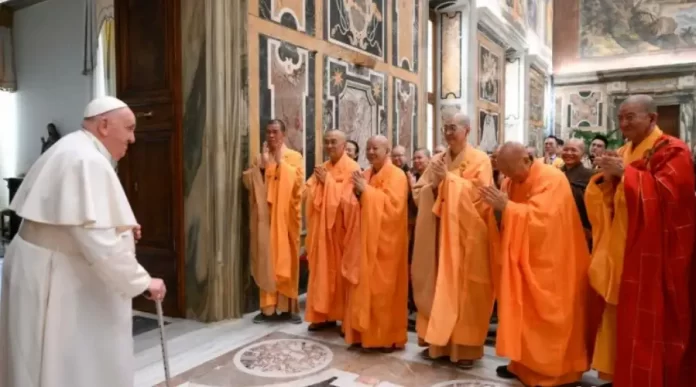Pope Francis received a hundred Taiwanese Buddhist monks, whom he thanked for making an interfaith pilgrimage to the Vatican. The pilgrimage made fostering a culture of encounter that “tears down the walls that divide,” added the Pope.
“The culture of encounter builds bridges and opens windows to the sacred values and convictions that inspire others. Tear down the walls that divide people and hold them prisoner of preconceived ideas, prejudice or indifference,” he said in his address to the United Humanist Buddhism Association (Taiwan) delegation on March 16.
The Pope emphasized that this “interfaith educational pilgrimage” to Catholic holy sites “can be a source of great enrichment, offering us multiple opportunities to meet, learn from one another, and appreciate our diverse experiences.”
In this sense, he assured that this “privileged occasion” allows “we risk opening ourselves up to others, hoping to discover friends and brothers in them”, and “discover more about ourselves”.
“As we experience others in their diversity, we are encouraged to step outside of ourselves and accept and embrace our differences,” the Holy Father acknowledged.
During his speech, Pope Francis also recalled that a pilgrimage like the one this Thursday can help to appreciate the singularities of approaching “the divine.”
“The masterpieces of religious art that surround us in the Vatican and throughout Rome reflect the conviction that, in Jesus Christ, God himself became a ‘pilgrim’ in this world out of love for our human family,” he explained to the Buddhist delegation.
In the case of Christians, “the God who became one of us in the humanity of Jesus continues to guide us on a pilgrimage of holiness, in which we recover and grow in our likeness to Him and thus become, in the words of Saint Peter, ‘participants of the divine nature’ (2Pe 1,4)”, he continued.
Throughout history, Francis explained, believers have created sacred times and spaces “as meeting oases, where men and women can obtain the necessary inspiration to live wisely and well.”
In this sense, he considers that such oases “are even more necessary in our time”, affected by “an intensified rhythm of life and work”.



